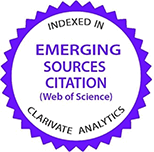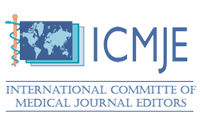Index








Applications



Membership



Volume: 5 Issue: 2 - 2017
| ORIJINAL ARAŞTIRMA | |
| 1. | The Associations of Plasma Levels of Beta Amyloid, Insulin, Insulin-Degrading Enzyme and Receptor of Advanced Glycosylation End Product with Cognitive Impairment in Type 2 Diabetes Mellitus Patients Yuliarni Syarita, Darwin Amir, Eva Decroli doi: 10.25002/tji.2017.550 Pages 31 - 35 Giriş: Diabetes mellituslu hastalarda bilişsel bozukluk görülme olasılığı, bu hastalığı bulunmayanlara göre daha yüksektir. Diabetes mellitus ile bilişsel bozukluk arasındaki ilişkiyi açıklayabilecek insülin direnci, artmış amlioid oluşumu, insülin yıkan enzim (İYE) ve ileri glikozilasyon son ürünleri reseptörü (İGSÜ) gibi bir dizi neden bulunmaktadır. Amaç: Bu çalışmada amaç, diabetes mellituslu hastalarda başlayan bilişsel bozukluk ile beta amiloid, insülin, İYE ve İGSÜ arasındaki ilişkiyi araştırmaktır. Yöntemler: Bu vaka kontrol çalışmasında, bilişsel bozukluğu olan 30 hasta ile olmayan 30 olgu karşılaştırıldı. Bilişsel bozukluk, bir nöropsikolojik test olan Montreal Bilişsel Değerlendirme Testinin Endonezya sürümü (MBDT-End) ile ölçüldü. Beta amiloid, insülin, İYE ve İGSÜ Elisa tekniği ile ölçüldü. Her iki gruptaki biobelirteç düzeyleri Mann- Whitney U testi, iki değişkenin arasındaki ilişki ise Ki-Kare testi ile değerlendirildi. Bulgular: Plazma insülin sevileri ile beta amiloid seviyeleri bilişsel bozukluğu olan hastalarda olmayanlara göre daha düşük bulundu. Plazma insülin seviyeleri ve beta amiloid ile bilişsel bozukluk arasında da bağıntı saptandı (p<0.05). Sonuç: Diabetes mellituslu hastalarda plazma insülin seviyeleri ve plazma amiloid düzeyleri ile bilişsel bozukluk arasında bir ilişki izlenmektedir. Background: Diabetes mellitus patients are at a higher risk of developing cognitive impairment compared to the nondiabetes mellitus population. There are various mechanisms underlying the association between diabetes mellitus and impaired cognitive function, including the failure of glucose metabolism, insulin resistance, and increased formation of amyloid beta, insulin-degrading enzyme (IDE) and receptor of advanced glycosylation end product (RAGE). Objective: This study aimed to find the association of the levels of beta amyloid, insulin, IDE, and RAGE with the onset of cognitive impairment in diabetes mellitus patients. Methods: A case control study was conducted on 60 patients classified as 30 subjects with cognitive impairment and 30 subjects without cognitive impairment. Cognitive function was examined using the Montreal Cognitive Assessment Indonesian version (MoCA-Ina) which is a neuropsychological test. The plasma levels of beta amyloid, insulin, IDE and RAGE were measured by Elisa technique. Mean differences in the levels of biomarkers in both groups were analyzed using the Mann-Whitney U test and the association between two variables was analyzed using the chi-square test. Results: It was found that the plasma levels of insulin and beta amyloid 42 were lower in the group with cognitive impairment and there was an association between low plasma levels of insulin and beta amyloid 42 with the occurrence of cognitive impairment (p<0.05) Conclusion: There seems to be a correlation between plasma insulin level, beta amiloid and cognitive impairment in patients with diabetes mellitus.. |
| 2. | Propolis Action in Controlling Activated T Cell Producing TNF-a and IFN-g in Diabetic Mice Febby Nurdiya Ningsih, Muhaimin Rifai doi: 10.25002/tji.2017.575 Pages 36 - 44 Amaç: Bu çalışma, propolisin hem aktive hem de TNF-? ve IFN-? eksprese eden T hücrelerine olan baskılayıcı etkisini araştırmak üzere yapıldı. Bu moleküller, diabetes mellitus (DM) koşullarında oluşan yangıda önemli roller oynar. Gereç ve Yöntemler: Bu çalışma in vivo olarak, streptozotosin ile oluşturulmuş diabetik farelerde yapıldı. Fareler; DM grubu (propolisin etanolde elde edilmiş ekstresinin verilmediği diabetli fareler), 50, 100 ve 200 mg/kg vücut ağırlığı dozunda propolis verilen diabetli fareler ve kontrol gruplarına ayrıldı. Tedavilerin etkisi 14 gün sonra, akan hücreölçer ile irdelendi. Bu yöntem ile dalaktan saptanan CD4+CD62L-, CD4+TNF-?+, ve CD4+IFN-?+ hücrelerin sayıları kaydedildi. Bulgular: Verilere göre, 14 gün boyunca uygulanan propolisin etanolde elde edilmiş ekstresi aktive olmuş T lenfositlerinin sayısını önemli ölçüde azalttı. Propolis ayrıca, T lenfositlerindeki TNF-? ve IFN-? ekpesyonunu da düşürdü. Propolisin tüm dozları kan glikoz seviyelerini ilk değerlerine göre anlamlı olarak düşürdü. 100 ve 200 mg/ kglık bir dozda propolis uygulaması, pro-enflamatuvar sitokinlerin ekspresyonunu baskılayabilir. Sonuç: Propolis, TNF-? ve IFN-? eksprese eden aktif T hücrelerinin sayısını azalttı. Aynı zamanda, saf T hücrelerinin de aktive olmasını engelledi ve hiperglisemiyi önledi. Objective: This study was conducted to determine the suppressor effect of propolis in controlling activated T cells, also T cells expressing TNF-? and IFN-?. Those molecules have an important role to generate acute inflammation in diabetes mellitus (DM) condition. Material and Methods: This study was done by in vivo experiment on streptozotocin-induced diabetic mice. Mice were classified into DM group (diabetic mice model without propolis ethanolic extract); propolis treatment group doses of 50, 100, and 200 mg/kg body weight; normal mice group. Effect of each treatment was observed after 14 days by flow cytometry analysis. The absolute numbers of CD4+CD62L-, CD4+TNF-?+, and CD4+IFN-?+ were assessed from splenic cells. Results: The data showed that administration of propolis ethanolic extract for 14 days significantly decreased the number of activated T cell. Propolis also decreased the expression of TNF-? and IFN-? by T cells. Administration of all doses of propolis caused decreased blood glucose level compared to baseline levels. Propolis administration at a dose of 100 and 200 mg/kg could suppress the expression of the pro-inflammatory cytokines. Conclusion: Propolis decreased the number of activated T cells expressing TNF-? and IFN-?. It also inhibited naive T cells to activate and prevented hyperglycemia. |
| 3. | Effect of Pro-inflammatory Markers on Gestational Diabetes Fatma Tuba Akdeniz, Zeynep Akbulut, Hakan Sarı, Hasan Aydın, Altay Burak Dalan, Dede Şit, Turgay İspir, Gülderen Yanıkkaya Demirel doi: 10.25002/tji.2017.586 Pages 45 - 50 Giriş: Hipergliseminin bir alt tipi olan Gebelik Diyabeti fetal ölüme ve gebelik sonrasında diyabet mellitusa neden olabilmektedir. İnflamasyonun gebelik sırasında diyabete yol açtığını bildiren araştırmalar olmasına rağmen, osteoprotegerin ve resistinin rolü henüz bilinmemektedir. Bu araştırmada, gebelik diyabeti ile i-lişkili olabilecek proenflamatuvar sitokinleri geniş bir perspektifle inceleyerek biyokimyasal parametrelerle birlikte değerlendirdik. Yöntem: Bu çalışma Gebelik Diyabeti tanısı almış 49 gebe ve 28 sağlıklı gebe kadın ile gerçekleştirilmiştir. Leptin, resistin, CD40L, TNF-R (Tümör Nekrotizan Faktör Reseptörü), OPG (Osteoprotegerin), MCP-1 (Monosit Kemoatraktan Protein-1), MPO (Miyeloperoksidaz), ICAM-1 (Hücreler arası adhezyon Molekülü) düzeyleri ölçülüp kan glukoz, HbA1c, total kolesterol, trigliserid, LDL ve HDL kolesterol düzeyleri ile birlikte değerlendirilmiştir. Sonuçlar: Resistin düzeyleri düşük düzeyde saptanırken, serum OPG (p=0,043) ve sTNF-R (p=0,001) düzeyleri sağlıklı kontrollere göre gebelik diyabeti olanlarda belirgin olarak artmış düzeydedir. Bu hasta grubunda, istatistiksel olarak anlamlı olmasa da, MPO, ICAM-1, CD40L ve leptin düzeyleri sağlıklı gebelerden daha yüksek düzeyde saptanmıştır. MPO ve trigliserid düzeyleri arasında pozitif yönde bir korelasyon varken, MPO ve HDL düzeyleri arasında negatif korelasyon olduğu saptanmıştır (p=0,017; p0,05). Tartışma: Pro-enflamatuvar belirteçlerin diyabette rolü henüz açıklığa kavuşmamış durumdadır. Gebelik diyabeti olanlarda inflamasyon belirteçlerinin yüksek oranda olması Gebelik Diyabeti patogenezinin anlaşılmasında yararlı olabilir. Daha büyük hasta grupları ile yapılacak çok merkezli araştırmalar pro-enflamatuvar belirteçlerin gebelik diyabetine etkisini açıklığa kavuşturucu olacaktır. Introduction: Gestational diabetes, which is a subtype of hyperglycemia; can cause fetal mortality and also may cause diabetes mellitus after pregnancy. Even though there are studies indicating that inflammation may cause the development of diabetes during gestation, roles of osteoprotegerin and resistin remain unknown. In this study, we aimed to evaluate in a broad perspective the pro-inflammatory cytokines which may be linked to gestational diabetes in relation to biochemical parameters. Method: This study was performed with 49 patients who had gestational diabetes mellitus (GDM) diagnosis and 28 healthy pregnant women. Serum levels of leptin, resistin, CD40L, TNF-R (Tumor Necrotizing Factor Receptor), OPG (Osteoprotegerin), MCP-1 (Monocyte Chemoattractant Protein), MPO (Myeloperoxidase), ICAM-1 (Intercellular Adhesion Molecule) were analysed and compared to blood glucose levels, HbA1c, total cholesterol, triglycerid, LDL and HDL cholesterol levels. Results: Serum OPG (p=0.043) and sTNF-R (p=0.001) levels were found significantly higher in GDM patients compared to healthy controls, whereas resistin levels were found lower. Even though a statistically meaningful difference was not observed, inflammatory markers MPO, ICAM-1, CD40L, and leptin were also found higher compared to control group. A positive correlation between MPO and triglyceride and negative correlation between MPO and HDL was observed (p=0.017; p<0.05). Discussion: The role of pro-inflammatory markers in diabetes is not clear. High levels of inflammatory markers in GDM patients may be helpful for clarifying the GDM pathogenesis. Multicenter studies with larger patient populations could enlighten the role of pro-inflammatory cytokines in GDM. |
| 4. | The Effect of Lactobacillus reuteri on the Percentage of Th17 Cells and Level of IL-17 in Staphylococcus aureus- Induced Puerperal Infection BALB/c Mice Uswatun Hasanah, Sitti Candra Windu Baktiyani, Sri Poeranto, Tatit Nurseta, Sumarno Reto Prawiro doi: 10.25002/tji.2017.539 Pages 51 - 60 Giriş: Lohusalık ateşi doğum sırasında veya lohusalık dönem Staphilococcus aureus enfeksiyonunun neden olduğu, toksik şok sendromuna (TSS) neden olan bir üreme sistemi enfeksiyonudur. Son 3 yıldır metisiline dirençlı Staphylococcus aureusun neden olduğu doğum sonrası enfeksiyonlarda artış olmuştur. Bu artış ta tedavi maliyetlerinin morbidite ve mortalite oranında artış olmuştur. Amaç: Bu çalışmada amaç Balb/c farelerde Staphylococcus aureus ile oluşturulmuş lohusalık ateşinde Lactobacillus reuterinin Th17nin ve Il-17 seviyelerine olan etkisi araştırmaktır. Yöntemler: Bu çalışmada, her grupta tam lohusalık döneminde olan 4 fare ile doğumdan 3 gün sonra gruplandırılmış 4 fare bulunduğu 4 fare bulunmakta idi: Grup I (Doğumdan 0-12 saat sonra Staphylococcus aureus verilmiş fareler), Grup II (sadece ağızdan Lactobacillus reuteri verilmiş fareler), Grup III (Lactobacillus reuteri ve Staphylococcus aureus verilmiş fareler), Grup IV (Kontrol). Akan hücre ölçer ile Th17 hücrelerinin oranı ve ELISA yöntemi ile IL-17 ölçüldü. Sunular: Çalışmada, Staphylococcus aureus ile oluşturulmuş lohusalık ateşi olan farelerde Lactobacillus reuteri verilmesinin Th17 hücrelerinin oranını ve IL-17 seviyesini düşürdüğü saptandı. Sonuç: Lactobacillus reuteri, Staphylococcus aureus ile doğum döneminde ve doğumdan 3 gün sonra oluşturulmuş lohusalık ateşinde koruyucu bir rol oynamaktadır. Background: Puerperal infection is an infection of the reproductive tract during labor or puerperal period, which is largely caused by Staphylococcus aureus infection resulting in Toxic Shock Syndrome (TSS). The prevalence of postpartum infection has increased over the past three years, coupled with an increase in Staphylococcus aureus (MRSA) Methicillin Resistant, resulting in high treatment costs and high morbidity and mortality rates. Objective: This study aimed to determine the effect of Lactobacillus reuteri on the percentage of Th17 cells and the level of IL-17 in Staphylococcus aureus-induced puerperal BALB/c mice. Methods: Mice were divided into 4 groups with each group consisting of 4 mice in puerperal period and 4 mice in three days postpartum period; Group I (mice were induced with Staphylococcus aureus at 012 hours postpartum), Group II (mice were administered orally with Lactobacillus reuteri), Group III (mice were treated with Lactobacillus reuteri and Staphylococcus aureus) and group IV (control). The percentage of Th17 cells was measured by Flow cytometry method, while the level of IL-17 was measured by ELISA method. Results: The results showed that the administration of Lactobacillus reuteri significantly influenced the percentage of Th17 cells and the levels of IL-17 in Staphylococcus aureus-induced puerperal mice. Conclusion: In summary, Lactobacillus reuteri may act as a preventive agent of puerperal infections in Staphylococcus aureus-induced mice during the puerperal period and three days postpartum. |




